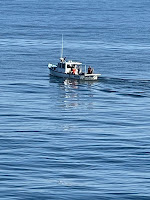Bar Harbor, Maine would be our last port of call and we arrived there early in the morning.
 |
| Fishermen checking their pots |
Since there are no facilities to accommodate the large cruise ships, we would have to anchor and tender into the town. As our pilot was taking us to our anchorage, we got to watch the “lobstah” fishermen tending their lobster pots. The fishermen had marker buoys identifying their pots scattered throughout the bay. We later learned that each fisherman can fish up to 800 pots which are usually placed in groups of 5-6 pots strung together and identified with specifically colored buoys on each end.
 |
| Fishing for "lobstahs" |
We also learned, that to a large extent, the fishermen self-regulate their industry by returning lobsters that are undersized or exceed the slot limit or are females with eggs or previously produced (a notch is cut in an egg producing female’s tail before being r
 |
| Really low tide |
Once ashore, we walked around the dock area looking at the gift shops and tour operators while we waited for our tour to begin. We had signed up for the “Gilded Age Walking Tour” which focused on the early part of the 20th century when the super-rich families in America made Bar Harbor their summer getaway. We met our guide, Anne, who started our tour by telling us that the very rich families came to Bar Harbor because of John D. Rockefeller’s wife, Audrey, who was pregnant and expecting to deliver mid-summer.
 |
| Former speakeasy |
Her obstetrician told her that he would not be able to deliver the baby, because he was going to spend the summer in Maine.
 |
| Congregational Church |
Bar Harbor has a population of just over 5000 residents, but that number swells dramatically during the summer and fall months with the influx of tourists and part-time residents.
 |
| Episcopal church altar |
Our group next stopped at the Bar Harbor Congregational Church, a New England Protestant denomination with Puritan origins—a Calvinistic group within the Church of England.
 |
| Tiffany stained glass window |
 |
| Episcopal cemetery |
We made our way back to the dock area and decided to get a couple of beers and a lobster roll at one of the dockside restaurants.
 |
| Jane's lobster roll |
Our last day aboard the ship was a sea day. Around mid-morning we started to transit the Cape Cod Canal which provided an interesting diversion to the open sea.
 |
| Cape Cod Canal bridge |
Disembarkation day and we are up early which is fortunate, because it allowed us to experience another sailing into New York harbor.
 |
| Canal community |
We did this in our boat in 2011 when we did the Great Loop. We passed under the Verrazano Bridge in foggy conditions. With our cabin on the starboard side, Jane had to go out onto the port-side deck to view the Statue of Liberty. As we watched the waterfront slide by, we reminisced about our experience in 2011 and the good times that we had.
 |
| Verrazano Bridge |
Our ship docked at Pier 88 and we were berthed right next to the USS Intrepid museum. We were the last group to disembark, and with two other large cruise ships docking at the same time, getting to our airport transfer was total mayhem. We finally boarded the bus that would take us to the airport and our flights back home.
And that’s all were going say about this trip!
 |
| Lady Liberty |
 |
| USS Intrepid |





















